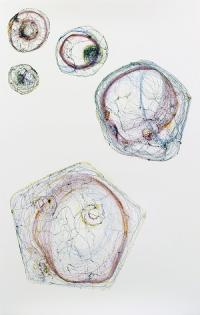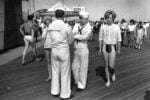Marcos Lutyens – Social pharmakon

Le tecnologie creano i social media come “oggetti temporali” che possiedono il potere di regolare i nostri ritmi, facendoli coincidere con il reale o creandone di paralleli. Possono rubarci il tempo, ma possono anche definire il rapporto tra le nostre menti e i nostri corpi. Un social media può essere considerato come un “pharmakon” – ovvero essere contemporaneamente medicina e veleno
Comunicato stampa
Le tecnologie creano i social media come “oggetti temporali” che possiedono il potere di regolare i nostri ritmi, facendoli coincidere con il reale o creandone di paralleli. Possono rubarci il tempo, ma possono anche definire il rapporto tra le nostre menti e i nostri corpi.
Un social media può essere considerato come un “pharmakon” – ovvero essere contemporaneamente medicina e veleno.
Marcos Lutyens presenta Social pharmakon alla galleria Arte Boccanera: parte di una ricerca relativa alla comunicazione interpersonale su Internet. Si tratta di un ulteriore sviluppo del suo interesse verso le nostre interazioni sociali, analizzate mentre le nuove tecnologie cambiano il nostro modo di essere. Traendo ispirazione da un dialogo nato nella "Reflection Room" con Carolyn Christov-Bakargiev a dOCUMENTA (13), Lutyens esplora i network di comunicazione come estensioni del mondo sociale esistente.
Lo scambio tra queste due prospettive invita il visitatore a prendere in esame i due diversi spazi e il modo in cui ci spostiamo, navigando tra l’uno e l’altro. La contrapposizione tra broadcasting media - radio e televisione - che utilizzano un sistema unidirezionale di comunicazione, e i social media, quali Facebook, Twitter, WhatsApp, ha provocato un drastico cambiamento nel modo in cui ci relazioniamo ma, in maniera più cruciale, ha inciso nella trasformazione del modo in cui la nostra mente interagisce con il mondo caleidoscopico che ci circonda.
Nel primo spazio della galleria, riconfigurata per l’occasione, Lutyens ha creato una sorta di diario interiore che monitora un processo di sovra-esposizione ai social media, utilizzando strumenti che scannerizzano le onde cerebrali, trasferite poi, tramite robot, su materia. Lo spazio successivo è costituito in relazione al visitatore che è, come sempre, il punto focale della ricerca dei progetti diLutyens. In questo caso viene esposto all’impatto dei segnali di notifica e poi immerso in un viaggio, intensificato attraverso suoni e odori, all’interno e al di fuori dei social networks. Il profumo creato deriva da una collaborazione con Saskia Wilson-Brown e l’Istituto di Arte e Olfatto di Los Angeles.
Correda l’esposizione un catalogo arricchito dal dialogo Carolyn Christov-Bakargiev – Marcos Lutyens, dagli interventi dei curatori e dalle immagini dei lavori esposti.
Marcos Lutyens (Londra, 1964. Vive e lavora a Los Angeles). La sua ricerca si basa su coscienza e dinamiche sociali; ha lavorato a progetti di larga scala che coinvolgono l'interattività, l'ambiente e le nuove tecnologie. I suoi interessi lo hanno portato ad esporre in tutto il mondo tra cui Museum of Contemporary Art, Los Angeles (2013), dOCUMENTA (13) a Kassel, Los Angeles County Museum of Art (2012), Centre Pompidou a Parigi (2010) e Royal Accademy of Arts, Londra (2009).
Technologies create social media as “temporal objects”, which can have both separating and unifying power. They can steal our time, but they can intensify the synchronization of our minds and bodies. It might be considered as a well-known meaning of pharmakon – cure and poison at the same time.
Marcos Lutyens presents Social pharmakon at Arte Boccanera Gallery. This body of work is based on research to do with inter-personal group communication on the Internet and is a further development of Lutyens’ interest in our social interactions, as new technologies change the way we are. Inspired by a dialogue born in the "Reflection Room" with Carolyn Christov-Bakargiev in dOCUMENTA (13), Lutyens explores electronic communication networks as an extension of the existing social world as we extend from one realm to the other and back again.
The interchange between these two realities invites the visitor to consider the two different positions, and how we navigate between them. The contrast between broadcast media – tv, radio – that uses one-way communication and social media, such as Facebook, Twitter, WhatsApp, or online networks has provoked a drastic change in the way we relate to each other, but more crucially it has impacted the way our psyche deals with the kaleidoscopic world around us.
In the first area of the gallery, which path is totally redefined, Lutyens has set up a kind of inner diary which tracks a process of extreme exposure to social media, using brainwave scanning equipment and robotic renderings. The next spaces relate to the visitor, who is, as always, the focal point of Lutyens’ research projects. These spaces explore the impact of push notifications as well as immerse the visitor in a smell-augmented journey through, into and beyond the social networks. The scent is derived from a collaboration with Saskia Wilson-Brown and the Institute of Art and Olfaction in Los Angeles.
Released for the opening the exhibition catalogue with the dialogue Carolyn Christov-Bakargiev – Marcos Lutyens, the curators’ essays, the works’ on show images.
Marcos Lutyens (London, 1964. Lives and works in Los Angeles). His research is based on consciousness and social dynamics, he has worked on large-scale projects that involve interactivity, the environment and new technologies. These interest led him to exhibit all over the world including the Museum of Contemporary Art, Los Angeles (2013), dOCUMENTA (13) in Kassel, Los Angeles County Museum of Art (2012), Centre Pompidou in Paris (2010), Royal Academy of Arts, London (2009).



